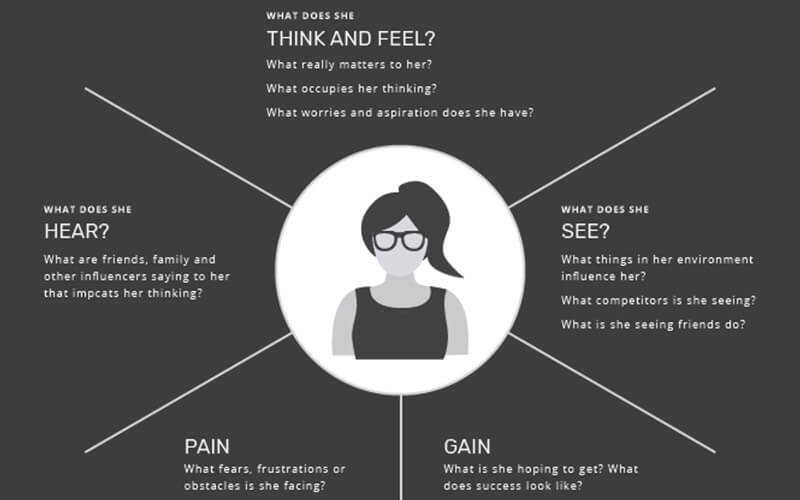Simple Tools You Can Use To Define Your Buyer Personas
Ardath Albee defines a persona as a “a composite sketch of a target market based on validated commonalities – not assumptions – that informs content strategy to drive productive buyer engagement (i.e., revenue)”.
More directly, buyer personas are fictional, broad characters who help you to define what your ideal and largest markets look like. They are used when determining who to target your products, services, branding or website design towards. They will typically include not just demographics information (age, location, income) but extend to psychographic information (interests, concerns, likes, dislikes, barriers to purchase) too.
There are many tools you can use to craft your buyer personas.
Such tools include:
- Research
- Data Tools – Review the data available to you internally; this includes your sales CRM tool, as well as any analytical information you have access to. Analytics data such as page views, top channel acquisition, in-market segments and bounce rates provide valuable insight as to your consumer needs and interests.
- Social Listing – Deep dive into publicly available information on platforms such as LinkedIn profiles, industry blogs and social media profiles of influencers to learn more about your target customers.
- Performance Testing – Utilizing internal tools such as existing content to run split tests or other research methods can provide quantitative proof that your initial assumptions used to create your personas were correct or incorrect.
- Surveys
- Customers – Survey your customers to find out more about their wants, needs and interests and to gather valuable information on what’s of importance to them in relation to your company.
- Sales Team – You may also want to consult with your sales team. In fact when gathering audience insights it is best practice to begin with your salespeople and by mining your existing CRM data. Salespeople often exist at the front line of customer interactions you they will have highly valuable information they can share. This also helps you create personas based on characters that your sales team is actively pursuing as potential customers.
- Interviews
- Target Customers – by conducting interviews with your target customers you will be able to determine relevant psychographic information relevant to their profile.
The platforms upon which you can carry out research, surveys or interviews include but are not limited to:
- Google Analytics
- Google Analytics lets you measure your advertising ROI as well as track your Flash, video, and social networking sites and applications.
- Similar Web
- A tool for benchmarking your performance against your online competitors.
- Facebook
- A social media tool for connecting with friends, family and other people you know. Share photos and videos, send messages and get updates. For business pages your page insights and your business manager ads platform provide valuable data.
- Instagram
- A simple, fun & creative way to capture, edit & share photos, videos & messages with friends & family. The analytics information in your business account dashboard can provide you with demographic insights into your followers and ideal customers.
- Mailchimp
- An email automation tool that helps you to find your audience, engage your customers, and build your brand.
- Survey Monkey
- SurveyMonkey is an online survey development cloud-based software that helps you to survey your customers, clients and audiences.
Empathy Mapping
Taking buyer personas one step further, empathy mapping is a valuable tool for gaining a deeper insight into target customers. Much like a buyer persona, an empathy map represents a customer segment and is a collaborative tool that teams can use to better understand their buyer personas. Keep in mind that empathy is your goal.
Empathy consists of two parts:
- The intellectual identification with the feelings, thoughts, or attitudes of another.
- The vicarious experiencing of those feelings, thoughts, or attitudes.
While closely related, empathy is not sympathy.
Here is a basic overview of what an empathy map looks like:

When creating an empathy map you might ask questions like:
- What would the user be thinking and feeling?
- What are some of the user’s pain points or fears about using our product?
- What are some of the users like and dislikes?
- What might the user say to others about using our product or service?
Empathy maps are useful for immersing yourself into your buyer persona’s headspace. They can be relevant when –
- Building out more detailed buyer personas
- Diving into customer segments
- Capturing behaviors that may become apparent in your customer interviews
- Defining your buyer persona ‘story’
Examples of Buyer Personas
As a guide to get you started on defining your own buyer personas here is an example of a buyer persona.

Buyer personas are never completely final; they should change as you learn new information about your customers and you may even stumble upon new buyer personas altogether. Either way, revisit your buyer personas every six months to review what you know and add new information.
